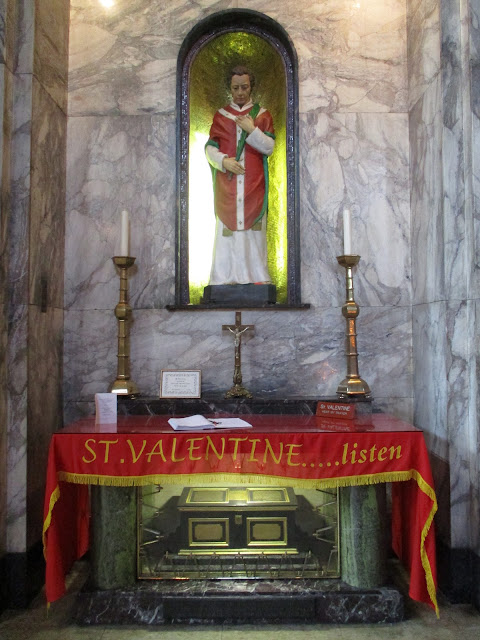Shrine of St Valentine
Dear Reader,
Prayer was offered for you at St Valentine's Shrine in White Friars' Church, Dublin.
St Valentine
St Valentine was a 3rd-century Roman saint, commemorated on February 14 by Western Christianity, Anglican communion and Lutheran churches. Eastern Orthodoxy commemorates St Valentine on July 6.
From the High Middle Ages Valentine's Saints' Day has been associated with a tradition of courtly love. Valentine is patron saint of people in love, Terni, epilepsy and bee-keepers.
Devoted clergyman
St Valentine was a clergyman - either a priest or bishop - in the Roman Empire. He ministered to Christians undergoing persecution in the Roman Empire.
A common hagiography describes St Valentine as a priest of Rome or as the former Bishop of Terni - an important town of Umbria, in central Italy.
While under house arrest of Judge Asterius and discussing his faith with him, Valentinus (the Latin version of his name) discussed the validity of Jesus.
Valentine tested
The judge is said to have put Valentine to the test and brought the judge's adopted blind daughter to him. If Valentinus succeeded in restoring her sight, Asterius would do whatever he asked.
Valentine, praying to God, laid his hands on the child's eyes and her sight was restored. The judge and his household of forty-four family members and servants were baptized.
Sentence of execution
Valentine was arrested again for arranging secret marriages for soldiers, in defiance of a marital ban imposed by Emperor Claudius II. After his arrest, Valentine was sent to the prefect of Rome and to Emperor Claudius Gothicus (Claudius II).
Claudius took a liking to Valentine until the saint endeavored to convince Claudius to become a Christian. Claudius declined and condemned Valentine to death if he failed to renounce his faith. Valentinus refused and was sentenced to be beaten with clubs and beheaded.
His execution took place outside the Flaminian Gate on February 14, 269. After Valentine's martyrdom, his body was buried at a Christian cemetery on the Via Flaminia.
Parchment hearts
It is believed that Valentine cut hearts from parchment which he gave to the married soldiers to remind them of their vows and God's love.
St Valentine's Shrine - site of pilgrimage
St Valentine's Shrine in White Friar Street Carmelite Church is a popular place of pilgrimage, especially on St Valentine's Day, for those seeking love.
The holy shrine resides in the Church of Our Lady of Mount Carmel and & Shrine of St Valentine (White Friar Street Church, Dublin). The statue at the shrine, cast by Irene Broe, shows St Valentine as youthful and bare-footed. The martyred Saint is holding a crocus-plant, generally regarded as one of the symbols of Spring.
Pope Gregory XVI entrusted the holy body of St Valentine to Father Spratt in 1835. Saint Valentine was brought to White Friars' Street Church in a steel casket on the 10th November 1836, with great solemnity and celebration culminating in a solemn high Mass at which Archbishop Murray of Dublin presided.
Fr Spratt ensured the reverent interment of the holy saint beneath the altar in Saint Valentine's Shrine in the church.
St Valentine's cards
The custom of sending "Valentine's" or love cards, especially among young people came, possibly, from the belief that February 14 - the Saint's feast day - marks the beginning of Spring and the courtship season of birds.


No comments:
Post a Comment